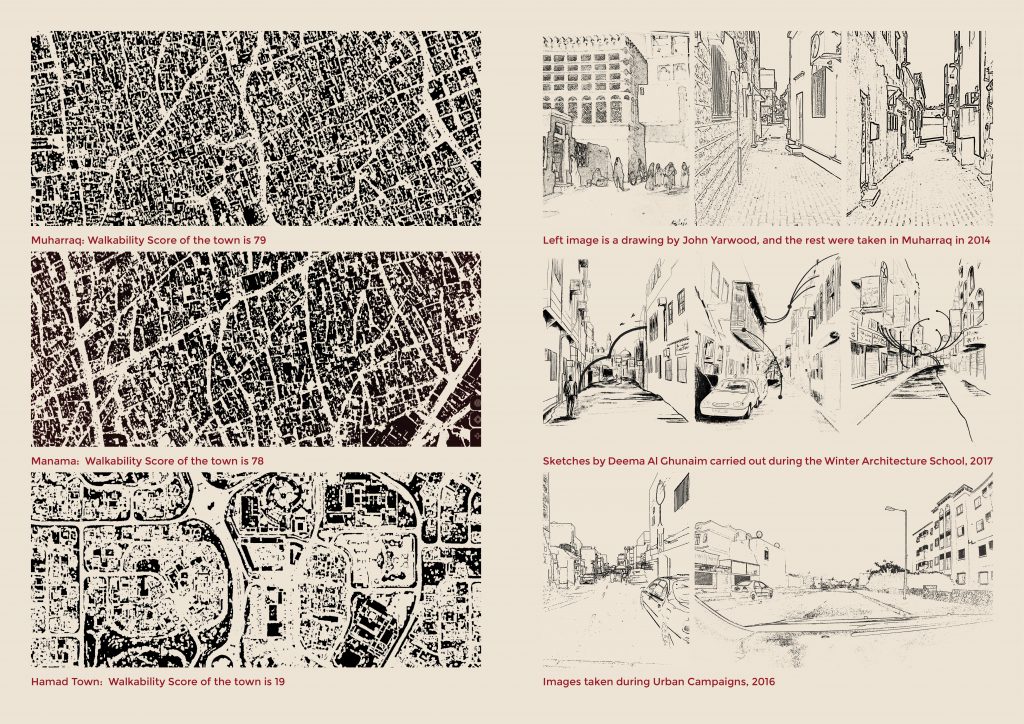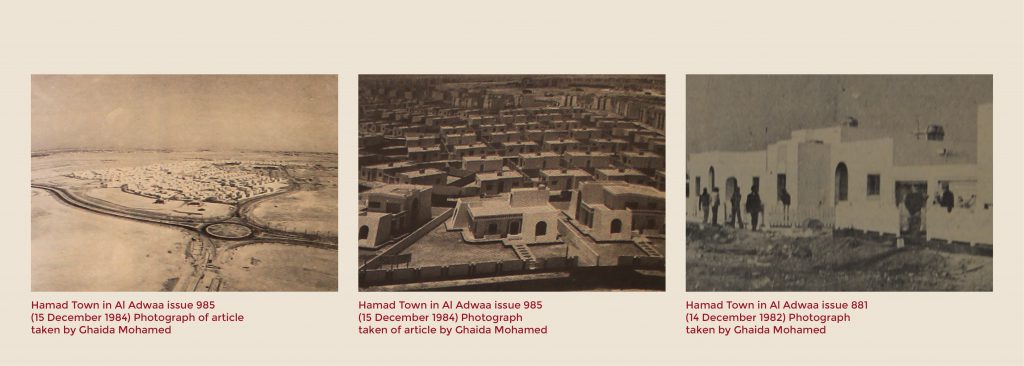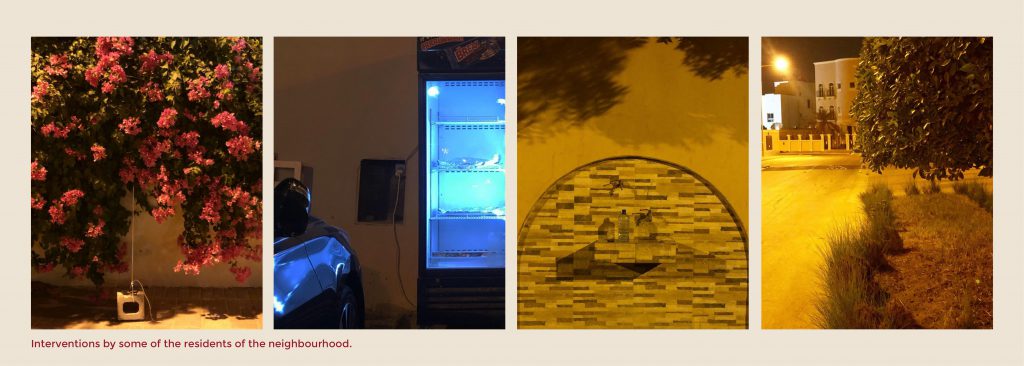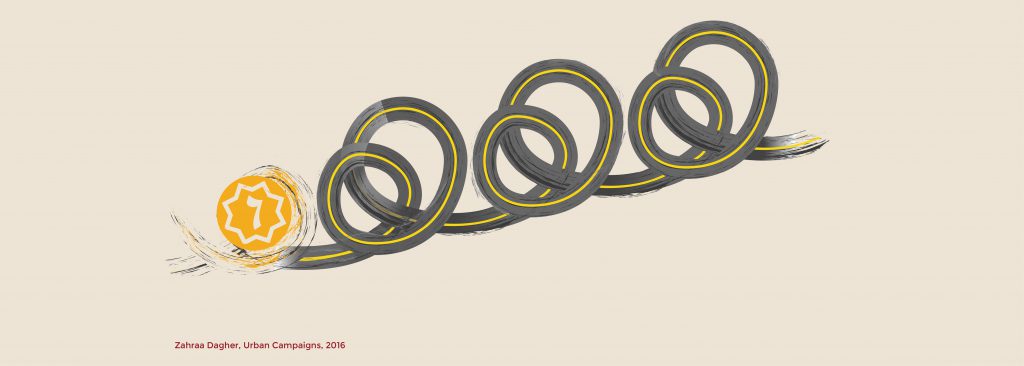Developing an Urban Prototype for a Walkable City
Published 11 February, 2022
Narjes Bukannan and Khushboo Shah
Mawane
Mobility is a key issue in the planning of sustainable cities. High car density poses many challenges for urban communities, where car traffic causes air and noise pollution, as well as obstacles and dangers for pedestrians. The Kanoo Mosque project by Mawane develops a model to study and respond to challenges facing car-led cities through the city’s own social structure.
The model is being developed around Kanoo Mosque in Hamad Town, Bahrain, where many visitors to the mosque travel the short distance by car. The space around the mosque is a central area used for other social activities and as a meeting place, which would benefit from being connected to other destinations in the same neighbourhood. Our urban prototype aims to provide the space with passive cooling systems and aesthetically pleasing interventions to encourage the space users to choose to walk as opposed to drive; serving as an urban prototype that can be replicated in other cities if successful.
The Roundabout Town: 22 to be Precise
Hamad Town was conceived in 1984 as a housing project and has become one of the largest populations and densest towns on the island. A wide North to South road with two lanes for each carriageway divides the linear town into an East side and a West Side. The 10 km road is interrupted by 22 roundabouts, numbered from 1 to 22 they become the markers and identification for each neighbourhood. The attention paid to the hierarchy of the roads indicates that the movement of cars was prioritised over pedestrian movement. As a result, the town today is a car-centric city, with a very low walkability index of 19%. In comparison, two of Bahrain’s older towns, Manama and Muharraq, have a walkability index closer to 80%, and the liveliness of their streets reflects how they emerged around the pedestrian.

Hamad Town with its wide roads, is often congested with cars clustered around its iconic busy roundabouts, and with very few recreational spaces. According to the World Health Organisation’s it is one of the 20 most polluted cities globally, with the primary pollutant being vehicles. Not only does vehicle pollution have direct environmental and health impacts, but a car-dependent lifestyle is further exacerbating non-communicable diseases (like obesity) and weakening social ties, both of which are pressing issues in new developments in the country. These issues highlight the need of an intervention that responds to the immediate issues of traffic congestion whilst at the same time as designing planning interventions that brings the community together.

Identifying Communal Nodes
Contributors to “Urban Campaigns” that was carried out by Mawane in 2016 in Hamad Town identified a few nodes of gatherings, including the vicinity of Kanoo mosque. The mosque afforded both an opportunity to work with a strong community as well as a case study through which to address the problems of congestion, low walkability, and quality of life. The project started with working with the community to design interventions along the existing spaces that would lessen the dependency on cars within the same neighbourhood. In the case of the country and the wider region, an intervention around a mosque is a replicable node, as it is one of the most frequently visited places in most neighbourhoods considering the local context and its cultural significance. Yet different focal spaces and communities can be identified in neighbourhoods in other cities to replicate the urban prototype model. The provision of a network of walkways to and from these focal points would also connect nearby facilities and residential areas creating options for walking.
Initial community surveys and site studies highlighted Kanoo Mosque as a social space used several times a day, especially on Fridays, when more than 200 people typically visited to pray at a time. This congregational feature makes it not only prominent, but also stresses on the need for an intervention that encourages healthy pedestrian movement and addresses the issue of congestion. Kanoo Mosque also becomes a centre of social activity at several times of the year when people meet to greet each other during times of festivities. The community of the mosque welcomed our project and were excited about the possibilities of developing pleasant walkable paths around the space. This intervention invites, encourages, and inspires users to maintain healthy lifestyles, environmental wellness, and a better spatial quality.
The importance of social connection to place
A challenge for urban planners in the design of sustainable urban communities is making spaces that are contextually situated, reflecting the culture, values and diversity of inhabitants and ways of urban living. A crucial part of the Kanoo Mosque interventions understanding the community’s values and preferences, done through surveys and interviews along with the research of local physical conditions as well as the site context and its existing uses. Inclusivity is central to designing sustainable communities, which serve the interested of all stakeholders, which is why the project process engaged in dialogue with stakeholders within the community, as well as the municipality, design firms.
One factor identified as discouraging people from walking to the Mosque was weak communal bonds between inhabitants and visitors, as well as people’s unfamiliarity with the area. This alerted us to the fact that the social component of the intervention was stronger than we initially accounted for. The design of the site intervention therefore includes features that promote social activity and interaction within the wider Mosque area, as well as considering physical and environmental factors. The project design includes vegetation studies, redefining as well as designing pathways, introducing elements of social interaction like exhibits, seating, and shading, with consideration for accessibility, energy efficiency, sustainable material choice, and social equity in the spaces. The project also highlights features that the community itself has set precedent for, such as maa’ sabeel (public water fountains) and community fridges, while also introducing new opportunities for creative engagement through art and play. In doing so we hope to create a social space across the network, inviting both mosque users and others who either live nearby or use nearby facilities, regardless of whether they frequent the mosque itself.

Stepping away from old habits
As emissions continue to increase, global temperatures will continue to rise. The effects of extreme heat will be further intensified in cities, especially those with fewer green spaces and waterways. High traffic density and congestion from car use is a primary cause of pollution; and poor urban planning has led to cities that favour polluting vehicles over the health and well-being of urban citizens.
Pedestrian-friendly cities have multiple co-benefits for health, environment, and social well-being, which is why our prototype for public space encourages walking and social interaction, whilst considering environmental factors within the physical design. The project also confronts the challenge of correcting unforeseen consequences of historical urban planning and design. Projects for public spaces require strong buy-in from authorities (in this case the municipality and Ministry of municipalities and works) and residents alike. This is further complicated by the public nature of the intervention. While there is a strong precedent for communal governance, designing the intervention to encourage sustained engagement is crucial and can be achieved through a collaborative approach by involving these various communities to ensure a sense of ownership. A holistic and inclusive approach to public space design can bring multiple co-benefits that help shape sustainable urban communities for now and in the future.
Narjes Bukannan and Khushboo Shah
February 2022
About the authors and the feature
Narjes Bukannan and Khushboo Shah work for the Bahrain-based non-profit, Mawane. Mawane is an independent non-profit founded as a platform for collaborative experimental architecture and urban research.
Sources:
Haider, L. (2007). Analysis of Hamad Town Urban Planning Using GIS Techniques. https://citeseerx.ist.psu.edu/viewdoc/download?doi=10.1.1.557.6936&rep=rep1&type=pdf
Jassim, M. et al. (2018). Spatial Distribution and Source Apportionment of Air Pollution in Bahrain using Multivariate Analysis Methods. Environment Asia 11(2) 9-22. http://www.tshe.org/ea/pdf/EA11(2)_02.pdf
Share
Co-creation!
Do you miss something here? Would you like to contribute? Please let us know: urbanfutures@slu.se

